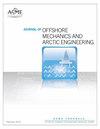OpenFOAM中基于倒置网格的数值波槽收敛特性分析
IF 2.1
4区 工程技术
Q3 ENGINEERING, MECHANICAL
Journal of Offshore Mechanics and Arctic Engineering-Transactions of the Asme
Pub Date : 2023-06-11
DOI:10.1115/1.4063265
引用次数: 0
摘要
本文针对OpenFOAM中基于overset网格的数值波浪槽进行了求解验证研究,该研究考虑了自由面水动力流动模型、刚体运动模型和overset网格之间的耦合。刚体运动求解器与自由表面流动求解器之间的耦合以分离的方式实现。利用数值波浪槽模拟了驳船横摇运动的自由衰减,并选择阻尼系数作为求解的目标值进行验证。采用基于最小二乘的解验证程序,其中四种误差估计量中的一种以最小二乘的方式拟合数据。对结构化网格和非结构化网格进行了测试,并仔细研究了它们对收敛阶、数值不确定性和误差的影响。数值试验表明,该数值波槽对结构网格浮体问题具有很好的收敛性,即在空间上接近二阶,在时间上接近一阶。然而,当将贴体网格转换为非结构化网格时,网格收敛降低到一阶。非结构化网格在时域上对收敛顺序没有明显影响,但由于数据的散射导致了较大的不确定性。本文章由计算机程序翻译,如有差异,请以英文原文为准。
Analysis of convergence behavior for the overset mesh based numerical wave tank in OpenFOAM
This paper presents a solution verification and validation study for an overset mesh based numerical wave tank in OpenFOAM, which considers the coupling between a free-surface hydrodynamic flow model, a rigid body motion model and an overset mesh. The coupling between the rigid body motion solver and the free surface flow solver was achieved in a segregated manner. Free decay of roll motion of a barge was modelled using the numerical wave tank, and the damping coefficient was selected as the target quantity for solution verification. The least square based solution verification procedure was adopted, where one of the four types of error estimators was fit to the data in the least-square sense. Both structured and unstructured mesh were tested, and their effects on the convergence order, numerical uncertainty and error were carefully investigated. From the numerical tests, it is found that the numerical wave tank exhibits a very good convergence property for the floating body problems with structured mesh, i.e. nearly second order in space and first order in time. However, when switching the body-fitted mesh to unstructured mesh, the grid convergence is reduced to first order. Unstructured mesh does not significantly affect the convergence order in time domain, but results in a larger uncertainty due to data scattering.
求助全文
通过发布文献求助,成功后即可免费获取论文全文。
去求助
来源期刊
CiteScore
4.20
自引率
6.20%
发文量
63
审稿时长
6-12 weeks
期刊介绍:
The Journal of Offshore Mechanics and Arctic Engineering is an international resource for original peer-reviewed research that advances the state of knowledge on all aspects of analysis, design, and technology development in ocean, offshore, arctic, and related fields. Its main goals are to provide a forum for timely and in-depth exchanges of scientific and technical information among researchers and engineers. It emphasizes fundamental research and development studies as well as review articles that offer either retrospective perspectives on well-established topics or exposures to innovative or novel developments. Case histories are not encouraged. The journal also documents significant developments in related fields and major accomplishments of renowned scientists by programming themed issues to record such events.
Scope: Offshore Mechanics, Drilling Technology, Fixed and Floating Production Systems; Ocean Engineering, Hydrodynamics, and Ship Motions; Ocean Climate Statistics, Storms, Extremes, and Hurricanes; Structural Mechanics; Safety, Reliability, Risk Assessment, and Uncertainty Quantification; Riser Mechanics, Cable and Mooring Dynamics, Pipeline and Subsea Technology; Materials Engineering, Fatigue, Fracture, Welding Technology, Non-destructive Testing, Inspection Technologies, Corrosion Protection and Control; Fluid-structure Interaction, Computational Fluid Dynamics, Flow and Vortex-Induced Vibrations; Marine and Offshore Geotechnics, Soil Mechanics, Soil-pipeline Interaction; Ocean Renewable Energy; Ocean Space Utilization and Aquaculture Engineering; Petroleum Technology; Polar and Arctic Science and Technology, Ice Mechanics, Arctic Drilling and Exploration, Arctic Structures, Ice-structure and Ship Interaction, Permafrost Engineering, Arctic and Thermal Design.

 求助内容:
求助内容: 应助结果提醒方式:
应助结果提醒方式:


